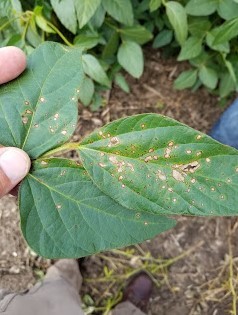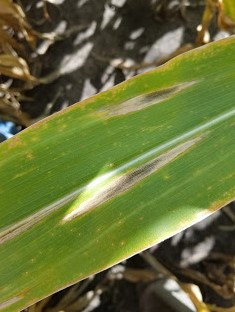By Bruce Potter and Dean Malvick et.al
As corn begins to tassel and soybeans near the R3 stage some may still be deciding whether a fungicide application to their fields will be helpful.
Over the past several years we have been conducting a study on potential yield benefits from insurance application of fungicides. These studies were conducted from 2016-19 (soybean) and 2017-19 (corn) and located at University of Minnesota Research and Outreach Centers.

Frogeye leaf spot on soybean. SWROC, 2018.
The studies were based on the premise that over time, a network of standardized fungicide studies can provide Minnesota farmers and their advisors information to better understand yield impacts from disease and return on pesticide investments.
At each study site and year, two fungicides were applied to several corn hybrids and soybean varieties at approximately the VT and R3 growth stages respectively. The fungicides were applied to rotated corn and soybeans. Unlike most pesticide efficacy studies, the sites were not selected based on anticipated crop disease pressure.
Briefly summarized, the results are:
- Disease pressure was low to moderate at all site-years.
- For corn, only 1 of the 11 site-years for corn showed a significant yield response for foliar fungicide application.
- For soybean, 9 of 17 site-years showed significantly higher yields where fungicides were applied, 8 of these were in southern Minnesota.
- Not all of the yield responses observed would have been economical.
- Moisture differences may be influencing the yield responses for both crops and these effects might change with harvest timing.
It is unlikely that applications of foliar fungicides on an insurance basis can overcome poor variety selection and other agronomic decisions. These results do not reflect the results expected when effective fungicides are appropriately applied to fields where significant disease occurs.

Northern corn leaf blight. SWROC, 2018.
Suggestions to improve the odds of return on a fungicide investment include:
- Disease has been observed when scouting.
- Short and long-term weather forecasts are favorable for disease.
- The hybrid/variety is susceptible to an observed or expected fungal pathogen (e.g. northern corn leaf blight, gray leaf spot, frogeye leaf spot).
- The timing for adding a foliar fungicide to a post-emerge herbicide application is seldom optimal. Adding an insurance insecticide to a fungicide application can produce undesirable results.
Source : umn.edu